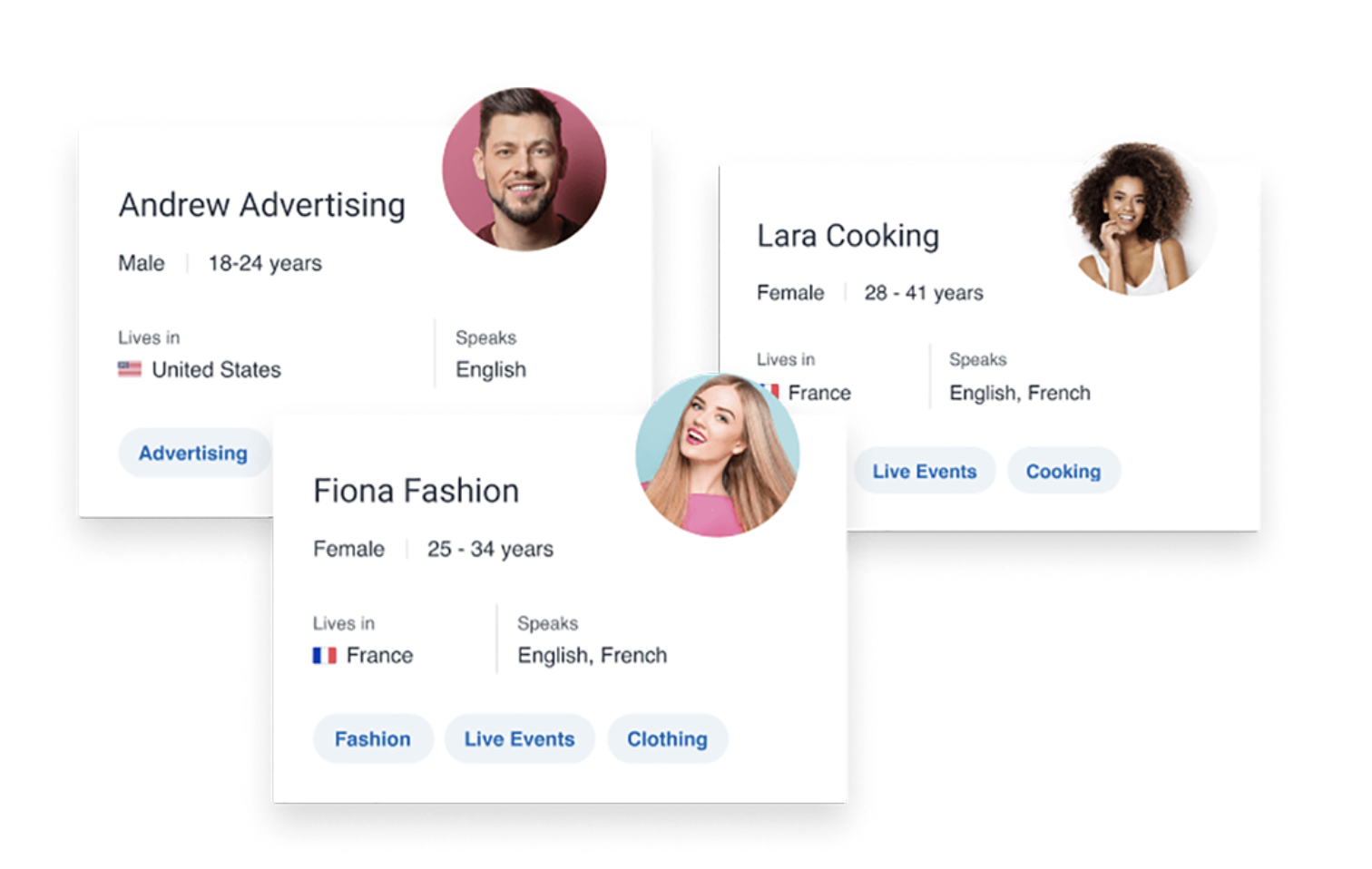While cleaning products are far from glamorous, one New Jersey-based company called Scrub Daddy recently amassed one million followers on TikTok by honing a memorable social media persona in its viral short-form videos. By using popular music tracks and poking fun at other sponge brands, Scrub Daddy’s most popular videos have been viewed over 20 million times, and the startup reportedly doubled its retail sales volume in the past year.
A social media persona refers to the tone of voice a brand uses to address its audience on social media. Ideally, the brand voice should reflect the company’s mission, vision, and values, as these shape the audience’s perception of the brand. A distinct voice is a key to building a relationship with your audience and standing out from the digital noise.
“Be mission-driven and express the values that you care for or stand for,” said Tani Lopez, founder of social media consultancy TANIcollective. “People love a good story on why you started your business and want to know whether you share the same values as them.”
So if you’re wondering how a social media persona can provide value for your brand, or are wondering how you can go about creating a persona, then look no further. In this guide, we’ll tell you all about the value and creation of a social media persona.
Social Media Personas Examples
Great social media personas exude a brand’s values and are often combined with humor that’s self-deprecating or pokes fun at their competition. Personas should be consistent and singular, which enables these brands to stand apart from the competition. Here are some examples of brands that are doing it right.
Wendys
Wendy’s is known for making good-natured barbs against rival fast-food chains and customers who ridicule the brand. The company is also reputed for responding to nearly every tweet and comment on its Twitter page, as seen in the below example. When one customer asked who runs Wendy’s notoriously snarky social media accounts, the brand quipped: “Three dogs in a trench coat pretending to be human.”

Disney
Disney’s brand concept is “Where dreams come true.” Seeing as Disney’s audience is children and their parents, the brand aims to reawaken the inner child in every adult’s heart. The brand uses dreamy vocabulary meant to ignite the imagination and seize upon the nostalgia of adults who grew up watching classic Disney tales. Disney’s brand voice is family-friendly and wholesome fun for all ages.
Fenty Beauty
The cosmetics brand launched by global pop star Rihanna is known for promoting inclusivity by working with models of all ages, body types, and races. Accordingly, the brand’s social media persona is designed to make fans feel closer to the singer and celebrate her Barbadian heritage.
“We all know Rihanna isn’t the one writing every caption or responding to direct messages, but her team is on point with making it sound like she is speaking directly to you through the content,” said Lopez.
Dove
Dove’s social media persona is strong, confident, and empowering. Its marketing campaigns live up to this tone of voice, promoting body positivity, gender equality, and racial diversity. In 2019, Dove launched the #ShowUs campaign partnering with women and non-binary people to create a collection of 10,000+ stock images that offer a more inclusive vision of beauty for all media and advertisers to use. Dove is a prime example of a company that uses imagery to tell compelling stories.
Dollar Shave Club
When Dollars Shave Club was founded in 2011, all of its social channels were run by CEO Michael Dubin himself, who also appeared in the company’s first online commercial. From then on, Dollar Shave Club’s social media brand voice has been in Mike’s voice. “We want you to feel like you are talking to your friend. We describe Dollar Shave Club as the smartest, hippest, coolest guy at the best party,” Connie Yu, social media marketing manager at Dollar Shave Club, said in an interview with Brandwatch.
Why Are Social Media Personas Important?
A relatable social media persona encourages engagement as customers can feel as though they are interacting with a real person, rather than a faceless corporation. Here are some other reasons why social media personas are so important:

More Reach
A consistent and distinct brand voice enables audiences to identify a brand across all platforms. To connect with your social media audience, you must speak their language.
“Personality is a critical component of growth to your brand because you need to stand out in the same ocean millions of businesses are swimming in,” said Amanda Harrison, social media manager at Hubilo. “It’s important to give brands humor, empathy, and real human emotions.”
People don’t just follow brands to hear about new products and services. They want content that is funny, informative, and sheds light on causes that matter to them.
More Engagement
Depending on the type of business, customers want to feel like they’re interacting with a good friend, a knowledgeable expert, or a trusted advisor. Ideally, your brand voice elicits positive emotions like humor, relatability, and credibility, which will induce followers to leave comments, share your content, or post about your brand. Treat social media marketing as a two-way street. The best brands start conversations and respond to their audiences, whether the feedback is positive or negative.
“Be engaging and open your platform to allow others to share their feedback, opinions, or thoughts,” said Lopez. “If you have been creating content without listening to your customer feedback, that means you’re not engaging enough with your community.”
More Conversions
A social media content strategy must strike the right balance between posting entertaining or informative content that isn’t sales-y, while also promoting the business’s products and services. Your social media brand voice should be engaging, informative, and persuasive while also using compelling sales copy with a clear call-to-action and value proposition. This helps to build a loyal following, convince your social media followers to visit your website, and then convert them into paying customers.

Cheaper Retargeting
Ad retargeting involves showing ads to audiences who have previously visited a brand’s website or social media profile. Customers are more likely to recall the brand when retargeted ads are written in a consistent brand voice, which increases the likelihood that they’ll click on the ad and complete a purchase.
Better Content
Your brand personality determines the type of content you post and the messaging you use. For example, if the brand is sassy or humorous, GIFs, memes, and funny short-form videos might be the most suitable content types. Another brand might focus on offering educational content such as how-to videos and infographics in order to build trust with its audience.
Consistent Brand Voice
Your social media voice must match your overall brand voice. A brand’s voice comes through every time you talk to a customer, respond to a comment, post on social media, or write an email. Consistent messaging creates the impression that customers are communicating with a real person rather than a corporate entity.
“Consistency creates familiarity, and familiarity invokes feelings of comfort,” said Harrison. “By making your customers feel comfortable, they’re more likely to engage.”
How To Create a Persona for Social Media
While a social media persona should embody brand values, it should also be based on a deep understanding of your customers. Let’s take a look at what that looks like:

Reference Your Marketing Personas (if You Have Them)
The first step to shaping a successful social media persona is to learn everything you can about your target customer. A marketing persona is a profile of your ideal customer or key segment of your customer base. Document everything you know about them with respect to demographics and qualitative data, including their age group, interests, income, and native language. More importantly, try to understand their pain points and core values.
Buyer personas determine the type of messaging that will appeal to your target market, which channels your audience uses the most, and what kinds of calls-to-action will drive them to your website. Brands that offer multiple product lines catering to different audience segments might craft a distinct persona for each segment.
Reverse Engineer Your Competitors
How do your competitors address their audience? Take note of the tone they use, the types of content they post, and which platforms they’re most active on. Next, find out whether their content strategy is paying off. Perhaps their follower count is high but engagement is low. If that’s the case, take cues from a different competitor. Pay attention to the types of social media posts that engender the most engagement. It’s highly likely that your competitors are targeting a similar audience, so analyzing their social media strategy can help you craft yours by proxy.
Review Your Audience Demographics
Demographic data tells you a lot about which social media platforms your audience favors and what type of messaging will resonate with them. For example, Facebook’s audience skews male and the largest age group is 25-34, while TikTok’s user base is 61% female with a predominant age group of 10-19.
Use a Template
Templates help you plan an effective digital marketing strategy. They make processes repeatable and ensure you use a consistent brand voice and aesthetic. For example, a template might contain sales copy or wording for a specific call-to-action (CTA).
Templates are also useful for reporting purposes—this way, you can easily highlight the social media KPIs that matter most to the business and make week-to-week or month-to-month comparisons.
Sanity-Check It Across Teams
Before going live with your new social media persona, get a second opinion from other teams. Brand cohesiveness is important, so make sure your social media persona aligns with the brand’s overall image. Finally, your social media content strategy should aim to increase organic engagement while also serving larger business objectives, such as increased sales or customer loyalty.
Finally, the persona will appear something like this –

How To Use Social Media Personas
A brand’s social media persona should be consistent with the voice you use throughout the entirety of your digital marketing campaign. Including accurate information about the brand, links to the website, and a cohesive aesthetic are key.
Update Your Profiles
Update your social profiles to reflect your brand attributes. This means including accurate brand information in the bio or “About Us” section. Visual elements such as the logo, cover photo, and profile picture should be consistent across all social platforms. Include a strong brand statement that highlights the values your brand stands for, the vision it embodies, and the mission it wants to accomplish. This helps people get easily acquainted with your brand identity.
Guide Future Content Planning
Establishing a brand voice makes it easier to create content because it not only sets the tone of your messaging, but it helps you better understand what types of content will be most useful and/or engaging for your audience.
Share Across Teams for Non-Social Media Marketing
Your social media persona should sound the same as the tone of voice used in your email marketing, content marketing, referral marketing, and advertising. This is why you need sign-off from cross-functional teams beforehand.
Social Media Persona FAQs
We’ve got the answers to all of your most pressing questions.
Is There a Difference Between a Buyer and a Social Media Persona?
A buyer refers to your paying customers. On the other hand, a social media persona refers to the brand voice and tone you use to communicate with current and potential customers on social media.
Can You Have Multiple Personas for Social Media?
It’s best to stick with just one, but you can change the tone and persona slightly depending on the message you’re trying to convey. For example, if you’re posting about something serious (eg: addressing a major PR incident involving your company), you’ll want to be transparent, informative, and apologetic.
Do You Need to Use Social Media Personas for Your Business?
Having a social media persona enables you to use a consistent voice and tone for all your social media profiles. Customers want to feel as though they are engaging with a real person rather than a faceless corporation, hence the importance of delivering a cohesive brand message and being personable on social media.
Since you’re here…
Ready to become a social media marketing guru? We’ve helped over 10,000 people switch into the career they want, and our new Social Media Marketing Certificate Course can do that for you. In 8-weeks of fully flexible learning and 1-on-1 work with industry experts, you’ll be ready to snap up a position in this growing industry. Check out our student reviews to get pumped



